The AMD Ryzen Threadripper 3960X and 3970X Review: 24 and 32 Cores on 7nm
by Dr. Ian Cutress, Andrei Frumusanu & Gavin Bonshor on November 25, 2019 9:05 AM ESTCPU Performance: System Tests
Our System Test section focuses significantly on real-world testing, user experience, with a slight nod to throughput. In this section we cover application loading time, image processing, simple scientific physics, emulation, neural simulation, optimized compute, and 3D model development, with a combination of readily available and custom software. For some of these tests, the bigger suites such as PCMark do cover them (we publish those values in our office section), although multiple perspectives is always beneficial. In all our tests we will explain in-depth what is being tested, and how we are testing.
All of our benchmark results can also be found in our benchmark engine, Bench.
Application Load: GIMP 2.10.4
One of the most important aspects about user experience and workflow is how fast does a system respond. A good test of this is to see how long it takes for an application to load. Most applications these days, when on an SSD, load fairly instantly, however some office tools require asset pre-loading before being available. Most operating systems employ caching as well, so when certain software is loaded repeatedly (web browser, office tools), then can be initialized much quicker.
In our last suite, we tested how long it took to load a large PDF in Adobe Acrobat. Unfortunately this test was a nightmare to program for, and didn’t transfer over to Win10 RS3 easily. In the meantime we discovered an application that can automate this test, and we put it up against GIMP, a popular free open-source online photo editing tool, and the major alternative to Adobe Photoshop. We set it to load a large 50MB design template, and perform the load 10 times with 10 seconds in-between each. Due to caching, the first 3-5 results are often slower than the rest, and time to cache can be inconsistent, we take the average of the last five results to show CPU processing on cached loading.
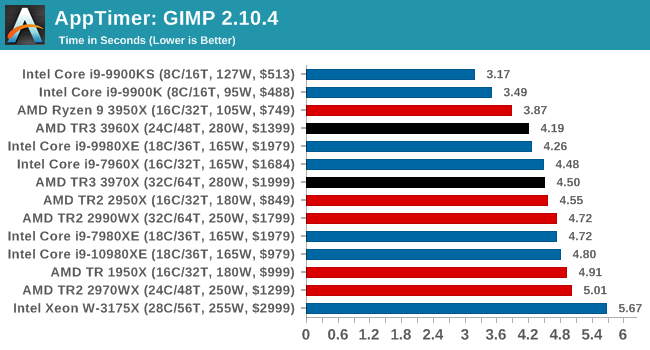
Onto our single threaded tests, and the mainstream hardware with high single thread frequencies wins here, but the 3960X is leading the rest of the pack. Intel's 28-core part here sits last, behind even the 1950X.
3D Particle Movement v2.1: Brownian Motion
Our 3DPM test is a custom built benchmark designed to simulate six different particle movement algorithms of points in a 3D space. The algorithms were developed as part of my PhD., and while ultimately perform best on a GPU, provide a good idea on how instruction streams are interpreted by different microarchitectures.
A key part of the algorithms is the random number generation – we use relatively fast generation which ends up implementing dependency chains in the code. The upgrade over the naïve first version of this code solved for false sharing in the caches, a major bottleneck. We are also looking at AVX2 and AVX512 versions of this benchmark for future reviews.
For this test, we run a stock particle set over the six algorithms for 20 seconds apiece, with 10 second pauses, and report the total rate of particle movement, in millions of operations (movements) per second. We have a non-AVX version and an AVX version, with the latter implementing AVX512 and AVX2 where possible.
3DPM v2.1 can be downloaded from our server: 3DPMv2.1.rar (13.0 MB)
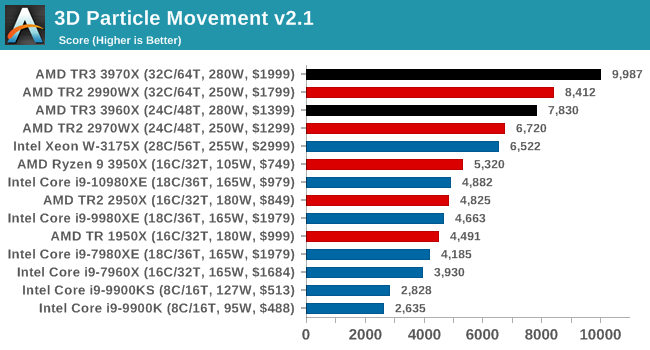
With non-AVX, AMD's floating point units put on a great performance.

This is a workload that can be AVX512 accelerated, and this is the main instance where we can see Intel's CPUs having an advantage.
Dolphin 5.0: Console Emulation
One of the popular requested tests in our suite is to do with console emulation. Being able to pick up a game from an older system and run it as expected depends on the overhead of the emulator: it takes a significantly more powerful x86 system to be able to accurately emulate an older non-x86 console, especially if code for that console was made to abuse certain physical bugs in the hardware.
For our test, we use the popular Dolphin emulation software, and run a compute project through it to determine how close to a standard console system our processors can emulate. In this test, a Nintendo Wii would take around 1050 seconds.
The latest version of Dolphin can be downloaded from https://dolphin-emu.org/
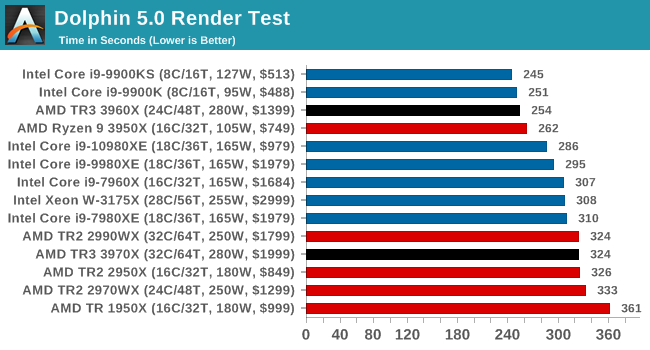
On the single threaded workloads again, and the high frequency mainstream CPUs win here. Interestingly, the 3960X also puts on a really good show, and actually beats our 3950X. Interesting.
DigiCortex 1.20: Sea Slug Brain Simulation
This benchmark was originally designed for simulation and visualization of neuron and synapse activity, as is commonly found in the brain. The software comes with a variety of benchmark modes, and we take the small benchmark which runs a 32k neuron / 1.8B synapse simulation, equivalent to a Sea Slug.
Example of a 2.1B neuron simulation
We report the results as the ability to simulate the data as a fraction of real-time, so anything above a ‘one’ is suitable for real-time work. Out of the two modes, a ‘non-firing’ mode which is DRAM heavy and a ‘firing’ mode which has CPU work, we choose the latter. Despite this, the benchmark is still affected by DRAM speed a fair amount.
DigiCortex can be downloaded from http://www.digicortex.net/
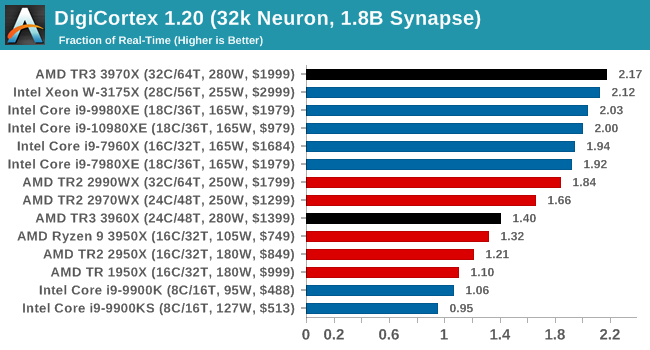
I'm surprised there's that much difference between the 3970X and 3960X here, especially with the 3960X sitting behind the TR2 processors. Might have to re-run this one to double check. But the 3970X puts out a commanding lead.
y-Cruncher v0.7.6: Microarchitecture Optimized Compute
I’ve known about y-Cruncher for a while, as a tool to help compute various mathematical constants, but it wasn’t until I began talking with its developer, Alex Yee, a researcher from NWU and now software optimization developer, that I realized that he has optimized the software like crazy to get the best performance. Naturally, any simulation that can take 20+ days can benefit from a 1% performance increase! Alex started y-cruncher as a high-school project, but it is now at a state where Alex is keeping it up to date to take advantage of the latest instruction sets before they are even made available in hardware.
For our test we run y-cruncher v0.7.6 through all the different optimized variants of the binary, single threaded and multi-threaded, including the AVX-512 optimized binaries. The test is to calculate 250m digits of Pi, and we use the single threaded and multi-threaded versions of this test.
Users can download y-cruncher from Alex’s website: http://www.numberworld.org/y-cruncher/
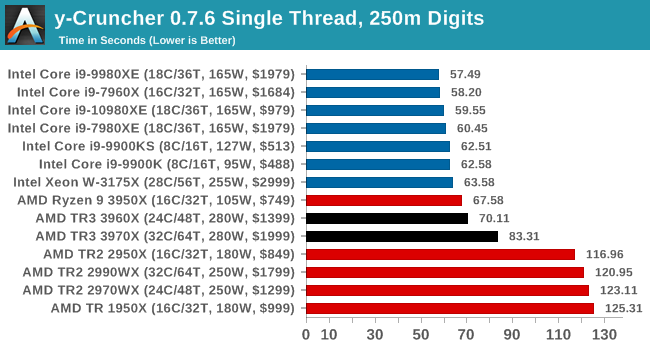
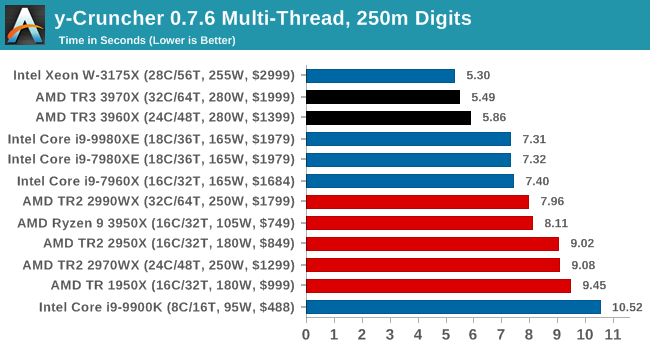
y-Cruncher is also AVX-512 accelerated, however when all the 32 threads come together in MT mode on AVX2, having that many pushes through 18 cores with AVX-512.
Agisoft Photoscan 1.3.3: 2D Image to 3D Model Conversion
One of the ISVs that we have worked with for a number of years is Agisoft, who develop software called PhotoScan that transforms a number of 2D images into a 3D model. This is an important tool in model development and archiving, and relies on a number of single threaded and multi-threaded algorithms to go from one side of the computation to the other.
In our test, we take v1.3.3 of the software with a good sized data set of 84 x 18 megapixel photos and push it through a reasonably fast variant of the algorithms, but is still more stringent than our 2017 test. We report the total time to complete the process.
Agisoft’s Photoscan website can be found here: http://www.agisoft.com/

New records for Photoscan as well.












245 Comments
View All Comments
Xyler94 - Tuesday, November 26, 2019 - link
Gotta love the "But what about this" with you fanboys.Did AMD beat Intel to the X86-64 Race? Yes
Did AMD beat Intel to the 1Ghz Race? Yes
Did AMD beat Intel to the true dual-core arc? Yes
Does AMD still continue to innovate and bring us better products, despite their peanut funding compared to Intel, while Intel just tries to weasel their way through the market? Of course. Do you honestly believe if TR3 wasn't so amazing, that Intel would have reduced their 18 core part to 1k out of the goodness of their heart? If you think that, you're more of a fanboy than I thought.
It is still known as AMD-64 today, because AMD found the way to do both 32bit and 64bit X86 at the same time, and Intel has to license that tech from AMD. Without AMD, Intel would not be releasing 8 core CPUs today. The reason for their shortages isn't really due to high demand, it's due to varying demand of their products. the 6-8 core silicon is different from their 4 core ones, and they needed to manufacture separate LCC and HCC core i9/Xeons, further hogging their supply chain. And there's also the fact the 9900k is also a legitimately great CPU, so people want it, further hurting the supply chain. Intel did this to themselves due to years of complacency, so I don't feel bad at all.
blppt - Wednesday, November 27, 2019 - link
"Did AMD beat Intel to the X86-64 Race? Yes"They didn't beat Intel to anything---Intel was going with IA64, never going with x64, Then AMD threw a MASSIVE wrench into those plans, lol. Intel was forced to then copy AMD64 with EMT64 when Itanium flopped.
But make no mistake---if AMD didn't create x86-64, Intel wouldn't have either. We'd all be running Itaniums and Itanium clones.
Qasar - Wednesday, November 27, 2019 - link
actually, for the most part, the industry didnt want ia 64, it would me a redo of most, if not all of the software just to use it, before they could even use it, with AMD64, you could keep using existing 32 bit software, and transition of 64 bit, when you can, or wanted to. amd just found a better, and quicker way to 64 bit then when intel was trying to cram down every ones throats."
But make no mistake---if AMD didn't create x86-64, Intel wouldn't have either." and chances are, we could be still using 32 bit cpus, as i said above, most, if not all of the industry didnt want to have to re compile all of the software we used then. and wasnt itanium slower then x86 over all ?
ahh yep.. it was slower : " By the time Itanium was released in June 2001, its performance was not superior to competing RISC and CISC processors. " from https://en.wikipedia.org/wiki/IA-64
Qasar - Wednesday, November 27, 2019 - link
would me a redo of most = would mean a redo of mostblppt - Monday, December 2, 2019 - link
One of the big reasons Itanium/IA-64 failed was that its "backwards compatibility" (i.e. x86 emulation) was much slower than the native x86 cpus out at the time.So, while they wouldn't need to redo all that x86 software, it wasn't exactly speedy while emulating.
To take full advantage of the IA64 architecture, yes, they would need to rewrite a lot of software, but it would have *run* without a rewrite.
And that's where x86-64 stepped in. 64 bit memory addressing, perfect x86-32 performance at a lower price.
But Intel was never going to create x64 by themselves unless the new EPIC/VLIW IA64 hit some kind of performance brick wall, or people just kept coding to x86 anyways (which Itanium would run, but slowly).
Bear in mind that part of the reason it was slow in 2001, x86 and Power had been extensively optimized compilers for a decade (or more for x86) and IA64 was in its nascent stages. Since it was never adopted by the mass public (include home users, etc), development of IA64 never came close to the level of development and optimization of x86.
Qasar - Tuesday, December 3, 2019 - link
either way you look at it, it seems AMD is doing more to move the cpu farther, then intel does. AMD seems to be the one that innovates, while intel sleeps. i know some who is a fan of intel, will refute this, but think about it... AMD improves the cpu, and moves it forward, while intel stagnates and stifles it..eva02langley - Monday, November 25, 2019 - link
Desktop and HEDT is not Intel business anymore. Just a matter of time for server and laptop to eat the same bullet.eek2121 - Monday, November 25, 2019 - link
I wouldn't say that AMD fans are wrong. Look at AMD's revenue years ago vs today. Do you think the growth came out of thin air? No, AMD is eroding Intel's marketshare. It hasn't begun to show yet, because the last reported earnings did not include Zen 2 eating into things. More and more people are buying AMD, and as long as AMD continues to execute as they have (and even more so: they have to get into bed with OEMs), Intel will gradually begin to suffer. They already HAVE suffered. Drastic price reductions on their highest end parts.eek2121 - Monday, November 25, 2019 - link
Oh and I should add that Intel is in a lot more markets than AMD. In addition, Intel actually does a ton of fab work for other companies. Intel makes networking cards, storage, and much more. So in translation: Revenue is meaningless. Intel does not have endless amounts of cash to throw at creating new CPUs, GPUs (which are coming out in 2021), and chipsets. What matters is marketshare. For Intel, it's shrinking.tygrus - Tuesday, November 26, 2019 - link
AMD have taken market share from Intel but it's not uniform across all markets. Fancy brand names, servers and ultra notebooks are still dominated by Intel and where the end-user isn't making a choice. Enthusiasts using a local store to select parts & assemble are a small market that have swung to AMD.